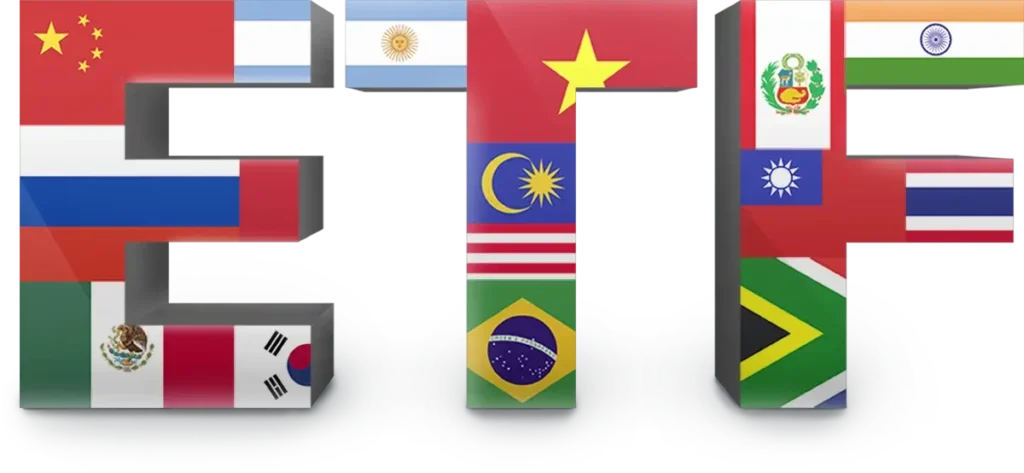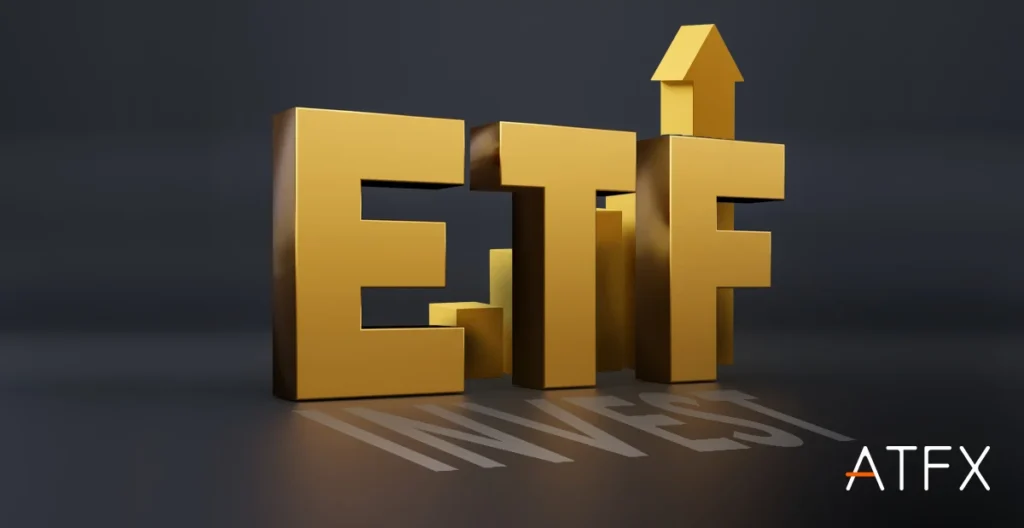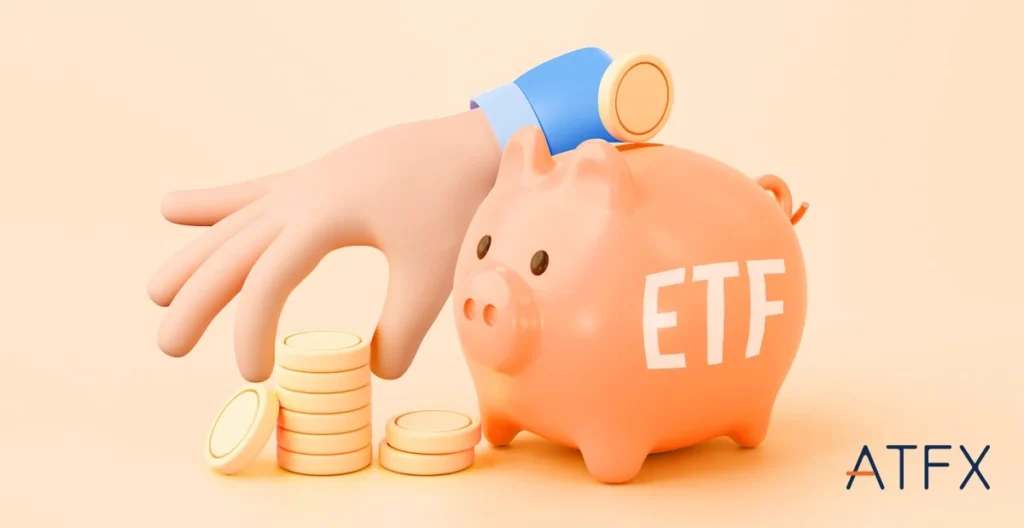Enjoy our 30+ ETF CFDs
Advantages of trading ETFs in UAE with ATFX
- 1:20 leverage
- Wide range of asset class to diversify portfolio
- Covered wide sectors & regions
- Underlying asset managed by fund manager
- Competitive spread
- No extra fee or commission
- Traders can trade the stock markets after-hours trading

ETFs in UAE Investment
Whenever you have cash constraints and prefer lower investment minimums, ETFs are a suitable option to enter the market. Simply put, you can buy a single ETF at the same price you would purchase a share at an index. For example, if you do not meet the minimum price for one share in a single company, you could buy an ETF in which the same company is one of the tracked instruments.
Exchange-traded funds make it easy to begin investing. They are straightforward and easy to understand. Therefore, a beginner investor can use ETFs to generate passive income with good returns.
For more clarity, here are some unique characteristics of ETFs and how ETF investment takes place.
In practice, when you buy an ETF, you buy fractions of a collection of multiple stocks in one go. An investor purchases shares in an ETF, and that money is spread out to buy a collection of attractive investments that meet a certain objective. For example, if someone buys the S&P 500 ETF, he indirectly invests among 500 companies listed in that index.

ETFs work a bit like mutual funds. However, mutual funds have a fixed daily price and a fixed purchase amount. Another small difference is that with mutual funds, all transactions take time. ETFs can be purchased just like stocks listed on major exchanges. The advantage ETFs have is that you only need to choose how many ETF shares you want to buy and trade them like stocks. The prices fluctuate throughout the day; anyone can trade them if the markets are open.
Difference between ETFs and Mutual funds
| ETFs | Mutual Funds |
|---|---|
| ETFs allow investors to simultaneously spread a single trade over many stocks and bonds. A single trade can capture many market segments. | Investors pool money to invest in a diversified portfolio. |
| You can buy ETFs from any exchange. | Investors must purchase mutual funds directly from the company that issues the shares. |
| Prices continually fluctuate when the market is open. You can purchase ETFs any time during market hours. | Mutual funds will have the market price fixed once per day. |
ETFs in the UAE: a Comparison With Mutual Funds
| Characteristics | ETFs | Mutual Funds |
|---|---|---|
| Diversification Benefits | ✔ | ✔ |
| Intraday Pricing | ✔ | ❌ |
| Options Trading | ✔ | ❌ |
| Margin Buying | ✔ | ❌ |
| Short Selling | ✔ | ❌ |
| Control over Capital Gains Treatment | ✔ | ❌ |
1. Passive & Active ETFs
Passive ETFs usually aim to track & match the performance of an index with low management fees. Meanwhile, active ETFs seek to outperform a certain index or indices by managing strategies with higher fees.
2. Expense Ratios
ETFs usually charge a fee referred to as the expense ratio. The expense ratio is marked as an annual percentage that reflects the total amounts you invest. Investing in ETFs with lower expense ratios tends to result in higher savings over time.
3. ETFs Pay Dividends
When you invest in ETFs as part of your portfolio, you can enjoy dividends that can be paid in cash or reinvested (dividend reinvestment plan).
ETFs in UAE: How much to Invest in ETF per Month
Trading ETFs in the UAE does not require a theoretical minimum or maximum amount of money you can invest. With its inherent diversification capabilities, ETF investment allows you to start with a small amount while gaining exposure to a range of stocks in one click. ETF can be traded similarly to how you would trade a stock, offering enhanced diversification.
Some brokers offer fractional shares, allowing you to invest with as little as $10, depending on the fraction of the ETF price.

Regardless of your investment amount, you need to factor in extra for the fees you might pay. Transaction costs are incurred when you make a purchase or a sale.
Commissions, some broker charge them while others offer zero-commission trading. Always confirm these fees and commissions with your chosen one before you trade.
As a trader you have the ability to purchase as many ETFs you want based on their price and your trading strategy.
When you make your first deposit, a broker or custodian company will hold your money. Use your created account to monitor your portfolio and available balances every time you log in.
ETF CFDs: Advantage of trading ETFs in UAE
Flexible trading options
Unlike traditional mutual funds, ETFs can fluctuate in price like stock prices. This allows you to trade by financing, shorting, or trading options, providing more flexibility than traditional mutual funds.
Portfolio diversity
Investing in ETFs is like investing in multiple securities at the same time, you can diversify your portfolio and reduce risk.
Transparency
ETFs are designed to mimic & track the composition of an index.
Global investment
Some ETFs track markets in different regions or even different countries. Making investing in ETFs a great choice for investing in U.S. stocks and overseas markets.
Lower cost
The cost of buying ETFs is usually lower than buying mutual funds. No management fees for ETFs traded with ATFX.
Trade ETFs in UAE with ATFX
ATFX offers 20+ new ETF CFDs with the most popular Financial, Technological, and Energy shares. You can trade these ETFs directly from your ATFX account. Get the best market prices and use our 1:20 leverage to trade larger positions.
ATFX gives you a convenient option to trade a contract-for-difference on ETFs. In trading CFDs, an investor does not have to purchase or sell a claim to an ETF on any exchange. They can trade on the price movements of the underlying ETF. A trader can go long or short without any ownership interest restrictions. (There is no ownership interest when you trade CFDs)
With CFDs, you can trade an ETF in any direction, from any market sector, and in any region around the globe. If you anticipate a decline in growth or value, you can short-sell an ETF CFD to profit from its value drop. Whenever you anticipate its value appreciating, you simply buy the ETF CFD.
ETF trading in CFDs allows you to apply leverage only to commit a small portion of the preferred notional value to enter a trade. This greatly reduces the capital requirements for trading ETFs. You can diversify and apply your capital over a broader range of trading opportunities.
With an ATFX account, you can trade a wide selection of ETF CFDs, giving you numerous options to match your investment interests. Furthermore, you only pay a small commission per trade, avoiding additional markups.
New ETFs in UAE Launched by ATFX
| Instruments | Name | Minimum Spreads |
|---|---|---|
| #ETF-ARGT | Global X MSCI Argentina ETF(CFD) | 0.05 |
| #ETF-ASHR | Xtrackers Harvest CSI 300 China A-Shares ETF(CFD) | 0.05 |
| #ETF-DIA | SPDR Dow Jones Industrial Average ETF(CFD) | 0.08 |
| #ETF-EEM | iShares MSCI Emerging Markets ETF(CFD) | 0.05 |
| #ETF-EFA | iShares MSCI EAFE Index ETF(CFD) | 0.05 |
| #ETF-EIDO | iShares MSCI Indonesia ETF(CFD) | 0.05 |
| #ETF-EPP | iShares MSCI Pacific ex-Japan ETF(CFD) | 0.05 |
| #ETF-EPU | iShares MSCI Peru ETF(CFD) | 0.05 |
| #ETF-ERUS | iShares MSCI Russia Capped ETF(CFD) | 0.05 |
| #ETF-EWH | iShares MSCI Hong Kong ETF(CFD) | 0.05 |
| #ETF-EWM | iShares MSCI Malaysia ETF(CFD) | 0.05 |
| #ETF-EWT | iShares MSCI Taiwan ETF(CFD) | 0.05 |
| #ETF-EWW | iShares MSCI Mexico ETF(CFD) | 0.05 |
| #ETF-EWY | iShares MSCI South Korea ETF(CFD) | 0.05 |
| #ETF-EWZ | iShares MSCI Brazil ETF(CFD) | 0.05 |
| #ETF-EZA | iShares MSCI South Africa ETF(CFD) | 0.05 |
| #ETF-GDX | VanEck Vectors Gold Miners ETF(CFD) | 0.05 |
| #ETF-GLD | SPDR Gold Trust ETF(CFD) | 0.05 |
| #ETF-GXC | SPDR S&P China ETF(CFD) | 0.05 |
| #ETF-ILF | iShares Latin America 40 ETF(CFD) | 0.05 |
| #ETF-IVV | iShares Core S&P 500 ETF(CFD) | 0.08 |
| #ETF-IWM | iShares Russell 2000 ETF(CFD) | 0.05 |
| #ETF-IYY | iShares Dow Jones U.S. ETF(CFD) | 0.05 |
| #ETF-KSA | iShares MSCI Saudi Arabia ETF(CFD) | 0.05 |
| #ETF-SMIN | iShares MSCI India Small Cap ETF(CFD) | 0.05 |
| #ETF-SPY | SPDR S&P 500 Index ETF(CFD) | 0.08 |
| #ETF-THD | iShares MSCI Thailand ETF(CFD) | 0.05 |
| #ETF-USO | United States Oil Fund ETF(CFD) | 0.05 |
| #ETF-VNM | VanEck Vietnam ETF(CFD) | 0.05 |
| #ETF-VNQ | Vanguard Real Estate Index Fund ETF(CFD) | 0.05 |
| #ETF-VTI | Vanguard Total Stock Market Index ETF(CFD) | 0.05 |
| #ETF-VUG | Vanguard Growth Index Fund ETF(CFD) | 0.05 |
| #ETF-XLE | SPDR Energy Select Sector Fund ETF(CFD) | 0.05 |
| #ETF-XLF | SPDR Financial Select Sector Fund ETF(CFD) | 0.05 |
| #ETF-XLK | SPDR Technology Select Sector ETF(CFD) | 0.05 |
Register for an account
Register Live Account
Complete the Live Trading Account application form & send all your e-KYC requirements.
Get Verified
We will verify and establish your identity through a series of security questions. Once we have verified identity, we will set up your account.
Start Trading
Start Trading & Fund Your Account. Go to your dashboard and fund your account to start trading online on our platforms.
FAQ
ETF is the acronym for Exchange Traded Fund. It is a type of security that tracks an index, sector, commodity, or other asset. An ETF can be purchased or sold on a stock exchange the same way a regular stock can. An ETF can be structured to track anything from the price of an individual commodity to a large and diverse collection of securities. When trading ETFs, you have many trading opportunities to choose from because the liquidity of an ETF reflects the liquidity of the underlying basket of shares.
Step 1 – Open an account with a broker
You need to have a broker who provides a platform for you to trade ETFs. luckily for you, we at ATFX provide ETFs with a commission-free basis. This ensures that costs will not be a major impediment as you start. Make a quick sketch and compare the brokers’ cost structures and the benefits available on their platforms. It is at this time that you should be on the lookout for attractive promotions that will help you grow your profits.
Next, consider the educational incentives provided on the platform. An extensive range of training and advisory tools like podcasts and webinars show that a broker also cares about the beginner trader’s investment.
The accounts are easy to create and verify, with most only taking about 10 minutes from start to finish. It would help if you had a bank account number (or a credit card) to ensure you can channel your funds to and from the broker with urgency and safety.
Step 2 – Choose the ETFs you like.
Most Beginners start trading passive index ETFs as they learn how to operate. They also do not get many surprises from analysts working for the fund. Index funds are also cheaper than those that experts manage. Historically, even managed funds do not beat the benchmark by a huge margin.
Step 3 – Buy ETFs with historical growth
Once you have funded the account, you can buy some small tranches of growth ETFs. You will need to search for the ticker symbols of the ETFs you have chosen and confirm them from the broker’s platform. Look at their chart performance to confirm you are watching the ETFs you intended to buy. Some broker platforms make it easy to buy ETFs from the platform’s research section. Otherwise, you can open the trade section listing all the ETFs and scroll to the preferred ETF.
Step 4 – Enter market order
Next, select the number of ETF shares you want to purchase and enter a market order. Entering a market order is instant than placing a certain limit order and waiting for the price to reach there. You can, however, place a limit order if you do not mind waiting.
Step 5 – Develop a follow-up plan
ETF trading is not a one-off affair. You will need to keep adjusting your portfolio to accommodate more opportunities. Some people identify some possible trades and accumulate them slowly over time. Furthermore, considering that many people invest in ETFs as a long-term savings plan, it is wise to have a fixed percentage of your monthly income going into your brokerage account. This will help you make more share purchases in the future so that you can reach your investment goals faster. Your broker and bank can let you have a cash standing order clocking into your trading account on an agreed timeframe.
Most beginners start by trading passive index ETFs as they are straightforward to manage and less influenced by analysts working for the fund. Additionally, index funds are typically cheaper than actively managed funds. Historically, even expert-managed funds do not outperform the benchmark by a significant margin.
Once your account is funded, you can start by buying small tranches of growth ETFs. Search for the ticker symbols of your chosen ETFs and verify them on your broker’s platform. Check their chart performance to ensure you are looking at the correct ETFs. Many broker platforms allow you to buy ETFs directly from the research section, or you can navigate to the trade section where all ETFs are listed and select your preferred ETF.